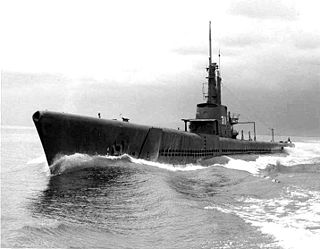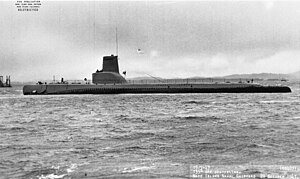
USS Volador (SS-490), a Tench-class submarine, was the second ship of the United States Navy to be named for the volador. The contract to build her was awarded to Portsmouth Naval Shipyard in Kittery, Maine, and her keel was laid down on 15 June 1945, but work on her construction was discontinued in January 1946. Her unfinished hulk remained on the ways until August 1947 when construction resumed, now including GUPPY II enhancements to the basic Tench design. Volador was launched on 21 May 1948 sponsored by Mrs. Harriet Rose Morton widow of Commander Dudley W. Morton, and commissioned on 1 October 1948, with Lieutenant Commander Howard A. Thompson in command.

USS Archerfish (SS/AGSS-311) was a Balao-class submarine. She was the first ship of the United States Navy to be named for the archerfish. Archerfish is best known for sinking the Japanese aircraft carrier Shinano in November 1944, the largest warship ever sunk by a submarine. For this achievement, she received a Presidential Unit Citation after World War II.

USS Pomodon (SS-486), a Tench-class submarine, was the only ship of the United States Navy to be named for the Pomodon genera of snapper.

USS Odax (SS-484), a Tench-class submarine, was the only ship of the United States Navy to be named for odax, a brilliantly colored, red and green fish belonging to the family Scaridae, the parrot fishes.

USS Medregal (SS-480/AGSS-480), a Tench-class submarine, was the only ship of the United States Navy to be named for the medregal, a streamlined, fast-swimming, bluish-colored fish of the jack family which abounds in waters of the West Indies and in the Atlantic as far north as the Carolinas.

USS Trumpetfish (SS-425), a Balao-class submarine, was the only ship of the United States Navy to be named for trumpetfish, any of several fishes so-called for their deep, compressed body and long, tubular snout. Her keel was laid down on 23 August 1943 at Philadelphia by the Cramp Shipbuilding Company. She was launched on 13 May 1945 sponsored by Mrs. Oswald S. Colclough, and commissioned on 29 January 1946 with Lieutenant Commander Raphael C. Benitez in command.

USS Quillback (SS-424), a Tench-class submarine, was the only ship of the United States Navy to be named for quillback, a fish of the sucker family, widespread in the freshwaters of North America and Northern Asia.

USS Caiman (SS-323), a Balao-class submarine, was a ship of the United States Navy that was later transferred to the Turkish Naval Forces in 1972 under the Security Assistance Program, where she was recommissioned as the third TCG Dumlupınar. She was retired in 1986.

USS Blenny (SS/AGSS-324), a Balao-class submarine, was a ship of the United States Navy named for the blenny, a fish found along the rocky shores of the Atlantic Ocean.

USS Brill (SS-330), a Balao-class submarine, was a ship of the United States Navy named for the brill, a European flat-fish.

USS Capitaine (SS/AGSS-336), a Balao-class submarine, was a ship of the United States Navy named for the capitaine, a brilliantly colored fish inhabiting waters of the Atlantic Ocean from North Carolina to Panama.

USS Chivo (SS-341), a Balao-class submarine, was a ship of the United States Navy named for the "chivo"" or big-scaled goatfish Pseudopenaeus grandisquamis, a fish inhabiting the Pacific Ocean between Panama and Mexico.

USS Greenfish (SS-351) was a Balao-class submarine of the United States Navy. It was named for the greenfish.

USS Jallao (SS-368), a Balao-class submarine, was a ship of the United States Navy named for the jallao, a pearl-white haemulonid food fish of the Gulf of Mexico.

The second USS Menhaden (SS-377) was United States Navy Balao-class submarine. Launched in 1944, she operated out of Pearl Harbor until 1946, then continued in use out of various ports in the Pacific until the 1970s. She was then decommissioned and re-fitted as a remotely controlled, unmanned acoustic test vehicle known as the "Yellow Submarine", until she was scrapped in 1988.

USS Segundo (SS-398) was a Balao-class submarine, of the United States Navy named for the segundo, a cavalla fish of Caribbean waters.

USS Pomfret (SS-391), a Balao-class submarine, was a ship of the United States Navy named for the pomfret, a fish of the seabream family which is a powerful and speedy swimmer, capable of operating at great depths.

USS Sea Fox (SS-402), a Balao-class submarine, was a vessel of the United States Navy named for the sea fox, a large shark, also called the thresher shark, which frequents the coast of Europe and the Americas.

USS Ronquil (SS-396), a Balao-class submarine, was the only ship of the United States Navy named after the ronquil, a spiny-finned fish found along the northwest coast of North America. It has a single dorsal fin and a large mouth and resembles the tropical jawfish.

USS Tiru (SS-416), a Balao-class submarine, was a vessel of the United States Navy named for the tiru, a member of the lizardfish family.




















